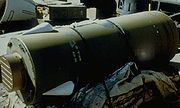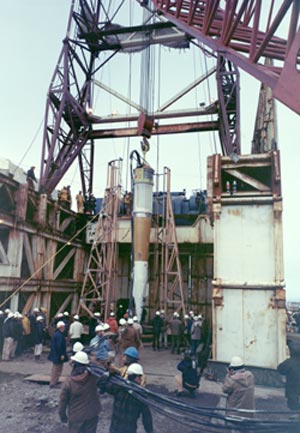
W71
Encyclopedia


Lawrence Livermore National Laboratory
The Lawrence Livermore National Laboratory , just outside Livermore, California, is a Federally Funded Research and Development Center founded by the University of California in 1952...
in California and deployed on the LIM-49A Spartan
LIM-49A Spartan
The LIM-49A Spartan was a United States Army anti-ballistic missile, whose warheads were developed at Lawrence Livermore National Laboratory. It was a three-stage, solid-fuel surface-to-air missile that carried a W71 thermonuclear warhead with a lethal radius of up to 30 miles to intercept...
Anti-ballistic missile. This was a component of an Anti-ballistic missile
Anti-ballistic missile
An anti-ballistic missile is a missile designed to counter ballistic missiles .A ballistic missile is used to deliver nuclear, chemical, biological or conventional warheads in a ballistic flight trajectory. The term "anti-ballistic missile" describes any antimissile system designed to counter...
defense system briefly deployed by the US in the 1970s.
The W-71 warhead had a yield of around 5 MtonTNT optimized for the production of thermal X-rays and minimal debris in an exoatmospheric detonation. The target would be damaged or destroyed by near-instantaneous x-ray vaporization of its surface resulting in an inward-propagating shock wave. The warhead package was roughly a cylinder, 42 inches (1.1 m) in diameter and 101 inches (2.6 m) long. The complete warhead weighed around 2850 pounds (1,292.7 kg).
Probably because of unique design features associated with x-ray production and emission from the thermonuclear component of the bomb, it was decided to conduct a full-yield test of the W-71. A prototype was successfully tested in Project CANNIKIN in the world's largest underground nuclear test, on Amchitka Island in the Aleutian Islands off Alaska
Alaska
Alaska is the largest state in the United States by area. It is situated in the northwest extremity of the North American continent, with Canada to the east, the Arctic Ocean to the north, and the Pacific Ocean to the west and south, with Russia further west across the Bering Strait...
. The W-71, mounted in a Spartan missile body, was lowered 6150 feet (1,874.5 m) down a 90 inches (2.3 m) diameter borehole into a man-made cavern 52 feet (15.8 m) in diameter. A 264 feet (80.5 m) long instrumentation system monitored the detonation. The full yield test was conducted at 11:00am local time November 6, 1971 and resulted in a vertical ground motion of more than 15 feet (4.6 m) at a distance of 2000 feet (609.6 m) from the borehole, equivalent to an earthquake of magnitude 7.0 on the Richter scale. A mile (1.6 km) wide and 40 feet (12.2 m) deep crater formed two days later.
Film of the test has been declassified and can be seen in the third of the Atomic Journeys documentaries Welcome To Ground Zero.
30 units were produced in 1974 and 1975. The weapons went into service, but were then taken right back out of service in 1975 and the warheads stored until 1992 when they were dismantled.

